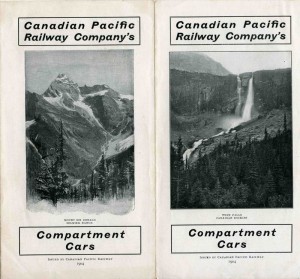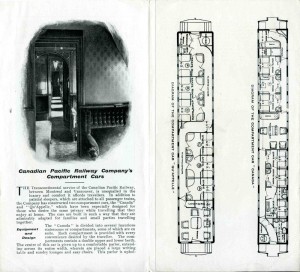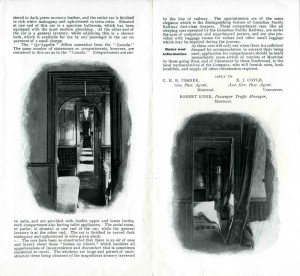Exploring the Walmsley Collection – 1904 CPR Pamphlet Promoting “Compartment Cars”


 Click on each image for a closer look!
Click on each image for a closer look!
.
In this post, we continue to share information and images of some of the items that were acquired in the David Walmsley collection. Many of the hardware items among these artifacts will be exhibited at the Toronto Railway Heritage Centre as space becomes available for internal displays. Some of the paper items are best shared in a forum like this, where people can appreciate them in the comfort of their homes.
.
1904 CPR “COMPARTMENT CAR” PAMPHLET
.
Highted here is a modest little pamphlet published by the Canadian Pacific Railway in 1904. The brochure promotes two “Compartment Cars” available for groups traveling together on CPR transcontinental trains and who purchase sufficient sleeping car space to justify the inclusion of one of these cars in the train’s consist. It would appear from the description that both these cars were constructed by the CPR, perhaps at their shops in the
east end of Montreal. At the time, the CPR also purchased a number of passenger cars from the Barney & Smith Car Company in Dayton, Ohio. Although no dimensions are given in the two floor plans, it would appear that the “Canada” was much longer than the “Qu’Appelle.” The latter’s name refers to a town and historic area of Saskatchewan on the CPR’s transcontinental route 33 miles east of Regina.
.
Although two detailed books have been published describing Canadian National’s passenger car fleet over the years, no such volume exists for Canadian Pacific. Author/historian Dale Wilson has been working on such an exhaustive project for several years. In 1983, Wayner published “A Century of Deluxe Railway Cars in Canada,” which included a CPR roster of first class cars. Neither the Canada nor the Qu’Appelle are listed in this book, which is generally regarded as containing significant omissions.
.
Though most of the railway era, the most basic type of sleeping accommodation was the section, which consisted of two facing seats during the day that were transformed into a lower berth at night. An upper berth then folded down from overhead, with each bed being sold seperately. The vast majority of sleeping cars built over the years featured 12 sections and one drawing room, which was completely private and which cost as much as three times as a lower berth. The lack of privacy in these sections and the fact that everyone shared common bathroom and toilet facilities provided comedic opportunities that were long a staple of Hollywood films, most significantly Billy Wilder’s 1959 classic “Some Like it Hot” with Marilyn Monroe. VIA Rail still provides upper and lower berths on the Toronto-Vancouver Canadian.
.
For those who sought more privacy and were willing to pay for it, the railways developed the compartment sleeping accommodation. These were complete sections that were enclosed and contained a sink and toilet. The cars described in the brochure each contained six such compartments which the CPR called State Rooms. Given that these cars were marketed towards groups and families, most of the compartments could be interconnected, doubling the size of the private accommodation, a feature still available on the Canadian.
.
The Canada featured a comfortable lounge area or parlour with leather upholstery in the centre of the car and an amenity only available today on the most luxurious trains in the world, a full bathtub. The car interior was white mahogany and at the other end was a shower bath, which apparently cost extra. The smaller Qu’Appelle contained no bathing facilities, was panelled in dark mahogany and featured the lounge on end of the car.
.
Although the brochure indicates that the cars were used in Montreal-Vancouver service, it seems likely that they would have appeared in Toronto at some point and would have been serviced at the old John Street facility.
.
If anyone has any more information on these cars, where they were used, and what became of them, we would appreciate hearing from you.
.
Derek Boles, TRHA Historian

